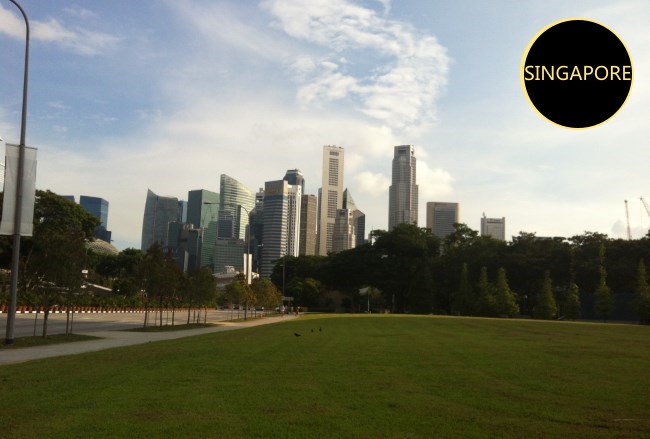Singapore, Simapore

It was 2am and the city of Singapore looked like a simulated toy town, illuminated by the white, artificial glare of streetlights and skyscrapers. The streets were immaculate, unpopulated and surrounded on all sides by glinting steel and glass reaching up to touch the inky black sky. I felt as though I had shrunk down to a millimetre and stepped into an architect’s model. It was all just a bit too perfect. It made me think of Sim City.
There was a time when I loved Sim City. I must have been around thirteen or fourteen and still able to stay awake for more than twelve hours a day because somewhere between school, eating and sleeping I managed to put in a good four hours of work on my city every day. I played compulsively for maybe a month and then never played again.
Vice ran an article a few years back about a man whose Sim City compulsion lasted four years. During which time he used mathematical formulas and principles of micromanagement to create the most populous and efficient Sim City possible, effectively ‘beating’ the game. He named his city Magnasanti and created a bizarre youtube video, with serious Seventies anti-christ horror film vibes, chronicalling his progress.
It would be a bit unfair to compare Singapore to Magnasanti. In the end, Magnasanti has a mortality rate of 50, no hospitals or schools and a population of incredibly unhappy Sims, whereas Singapore is considered to be one of the most liveable cities in the world, whatever that means. I couldn’t help feeling that something was missing in Singapore, though, that in its affluence and hyper-efficiency Singapore had lost something, I just didn’t know what.
The Singapore streets are not a lively cacophany of haggling, hawking and hustling as in other big East Asian cities. The shopping malls look just like the shopping malls in any other contemporary city, although probably cleaner than most. On the subway system commuters cram into carriages, plug in and switch off. The same way they do on the Skytrain in Vancouver, the MRT in Bangkok or the Tube in London, people plug their ears and stare at their screens, swaying shoulder to shoulder in a perfect tableau of global city life.
For the uninitiated and budget-conscious, being in Singapore can feel like window-shopping. We seemed to walk forever on a conveyor belt of giant shopping malls and department stores, going nowhere. We window-shopped the Singapore lifestyle too as disconnected spectators, trying to get our bearings in a city where we were constantly disorientated by skyscrapers and spend most of our time indoors.
There is a clear ‘no loitering’ policy in Singapore, even in places you’ve always thought of as public space like train stations or street corners or walkways in malls. If you want to sit down, you better hope you have money in your pocket to buy a cup of coffee. To be wealthy means to have the liberty of choice and the freedom to be anywhere; with little money and no desire to partake in any of the top tourist activities like Universal Studios, Night Safari, Cocktails at Raffles, we spent quite a bit of time those first few days just trying to find a place to be.
Still unsure about exactly what it was I expected from Singapore and what it was failing to deliver I did the only thing I could do at this point, I went to the Singapore State Museum.
I, like most, can be guilty of fetishising the past and when I’m on foreign soil this tendancy goes into overdrive. Has Singapore’s mall culture flatlined the idiosyncracies of cultural identity and the efficiency of its infrastructure santitised the living culture of the streets?
There are more ‘heritage shophouses’ in Singapore than there are in UNESCO world heritage awarded Georgetown in Penang, but they’re shells. Restored with a heavy hand these shops now house restaurants or flashy boutiques, not the descendents of migrant tradesmen and craftsmen. Old buildings are torn down to make way for the new, ‘vintage’ isn’t really a thing and last years gadgets are in the bin.
Nostalgia can blinker your perception of the world. We Brits thrive on it, that sense of some lost golden age when everything was simple and beautiful, everything was better. The sad claim that ‘it’s not like it used to be’ can be applied to everything from service in restaurants, to the local park to your favourite brand of instant mash.
A post-colonial independent state since 1965, Singapore is not yet old enough to embrace the sociopathic nostalgia that plagues the British Isles. Nobody here romanticises the past, they don’t want what came before, they only want what’s coming next. That’s not to say culture and tradition is missing here, you only have to walk down a street with a mosque, a church, a Hindi temple and a Buddhist shrine or eat at any one of Singapores hawker centres to see the true multi-cultural nature of Singapore as lived.
In order to experience contemporary Singapore you have to embrace all of it, billionaire-friendly hotels and soulless shopping malls nonewithstanding. There’s a freedom in that, a freedom that has helped Singapore to become the truly multi-cultural, hyper-modern Sim City it is today.

